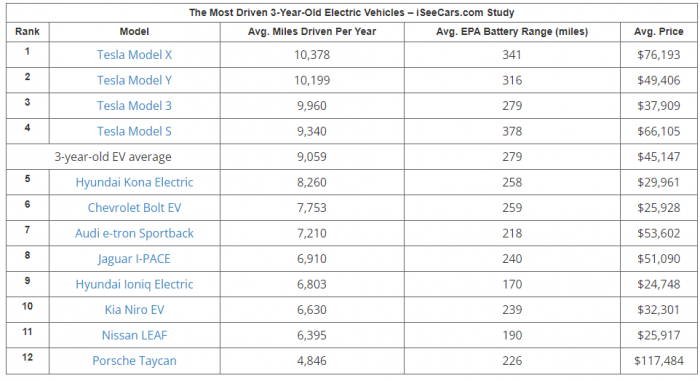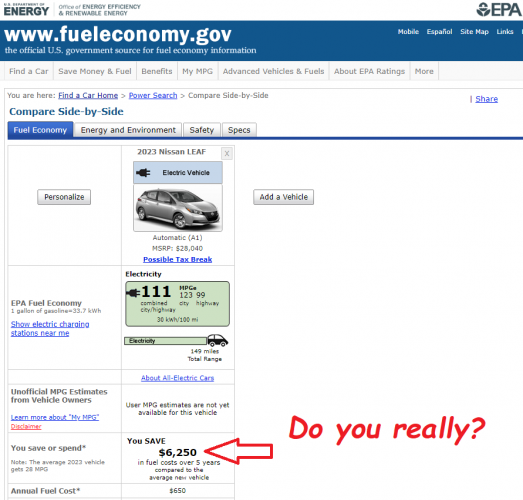iSeeCars has recently concluded a study that sheds some light on how many miles most battery-electric vehicle owners drive each year. The surprising conclusion is that owners of affordable battery-electric vehicle models hardly use them. The data shows that owners only drive them about half the annual miles that owners of conventionally-powered vehicles do.

What this means is that affordable battery electric vehicles are not really having the positive environmental impact many may advocates claim. It is quite common to hear that EVs are replacing internal combustion engine (ICE) vehicles, but are they really? Or are the EVs being purchased by owners who still use ICE vehicles for their long hauls and long commutes? If EV owners are only driving half the miles a typical ICE car covers in a year, then the impact the vehicles have in reducing annual greenhouse gas emissions is also just half of what might be assumed. And any energy savings measured in dollars also half.
In the study, the popular Nissan Leaf, now entering its fourteenth year of production, was one of the affordable EV models driven the least by owners. The Leaf has always been among the most affordable vehicles for sale with a plug, and thus, it is the most accessible EV for shoppers. The study shows that the average Nissan Leaf covers only about half the miles per year that most conventional-powered vehicles are. The annual miles average for the Leaf is a measly 6,395, compared to the 12,758 miles that iSeeCars found to be the average for conventionally-powered vehicles.

In addition to casting into doubt the climate change impact barely-driven EVs offer, the EPA’s annual fuel savings numbers are meaningless when you consider that the EPA considers 15,000 miles to be the average covered by drivers. The EPA makes EV energy savings a large bold font on its window stickers and its website. The annual miles are then shown in the tiny fine print.
The most-driven affordable EV is the Hyundai Kona EV (one of our favorite EVs, by the way). The average Kona is driven about 8,260 miles, according to the study. That’s about 35% less than the average internal combustion engine vehicle. None of the EVs in the study were found to meet the annual average miles driven by internal combustion vehicles. Not a single model.
If iSeeCars’ data is correct, the easy conclusion is that EV owners don't use cars the same way internal combustion vehicle owners do. Many use them as city-only cars, or local runabouts. In the case of the Porsche Taycan, the EV with the least annual miles (just 4,846 on average), perhaps it is typically a Sunday touring car or golf-day vehicle.
Related Story: Tesla Dominates New List of Electric Vehicles Owners Drive Most
The data looked at the annual miles driven by owners of vehicles that are three years old. Why that age? Well, it’s pretty hard to pin down how many miles a driver averages per year in their first year of ownership since it is ongoing, so that rules out that model year. Also, it is much easier to see the miles driven when you want to study a population of hundreds of thousands of vehicles if you look back a few years and study sales and registration records.
This latest data set points to a stark difference in how EVs are used versus how conventional vehicles are used. What would you say is the reason? The iSeeCars study page offers some theories you can read here.
John Goreham is an experienced New England Motor Press Association member and expert vehicle tester. John completed an engineering program with a focus on electric vehicles, followed by two decades of work in high-tech, biopharma, and the automotive supply chain before becoming a news contributor. In addition to his eleven years of work at Torque News, John has published thousands of articles and reviews at American news outlets. He is known for offering unfiltered opinions on vehicle topics. You can follow John on Twitter, and TikTok @ToknCars, and view his credentials at Linkedin
Image by John Goreham. Chart courtesy of www.FuelEconomy.gov.












Comments
Not being able to find a
Permalink
Not being able to find a place to charge the battery or having to wait a long time for it to charge would be my fear. So I would only drive it short distances and use my gas powered car for most trips.
So, we can’t assume that much
Permalink
So, we can’t assume that much about these statistics for a few reasons:
1. what has happened in the world the last 3 years??? THE PANDEMIC! That has skewed how people drive, especially how people in large metropolitan areas. To assume that the stats for any of these EVs for the last 3 years is inactive of patterns going forward would be presumptive.
2. You have to look at who buys EVs… they aren’t exactly entry level priced vehicles for the most part. People buying cars for driving lots of miles (I mean more than 15k miles… which isn’t the average annual mileage in the US actually, 13,500 is the average according to Car and Driver: https://www.caranddriver.com/auto-loans/a32880477/average-mileage-per-year/#) are perhaps more likely to buy cheaper, perhaps used vehicles because they are going to put 100K+ miles on them in a few years time. So a $10k used car (or something like that) makes more sense. Since pretty much no EVs costing 10K are likely to be able to cover 30-60K miles per year easily, people aren’t buying EVs for that purpose… they are buying gas powered cars (or maybe HEVs). If one can afford a new 250+ mile EV and has the option to charge at both ends of a long commute, or fast charging for low enough cost, then yeah, maybe they’ll buy an EV for that commute… but otherwise, the math might not work.
I might be one good data point. Before the pandemic, I drove two plug in cars (an EV - Model 3, and a PHEV - Volt). I covered about 25k annually between the two cars. The PHEV was mostly covering commuting miles, the EV was mostly covering longer road trips + some commuting. During the pandemic, my miles were cut in half (because we really didn’t have to commute for work any more). Now, as the pandemic ends and driving for work is more of a thing again, we are moving back toward that model… but many people were probably in somewhat similar circumstance. I think you need to look at older data, or revisit this analysis in a year or two from now.